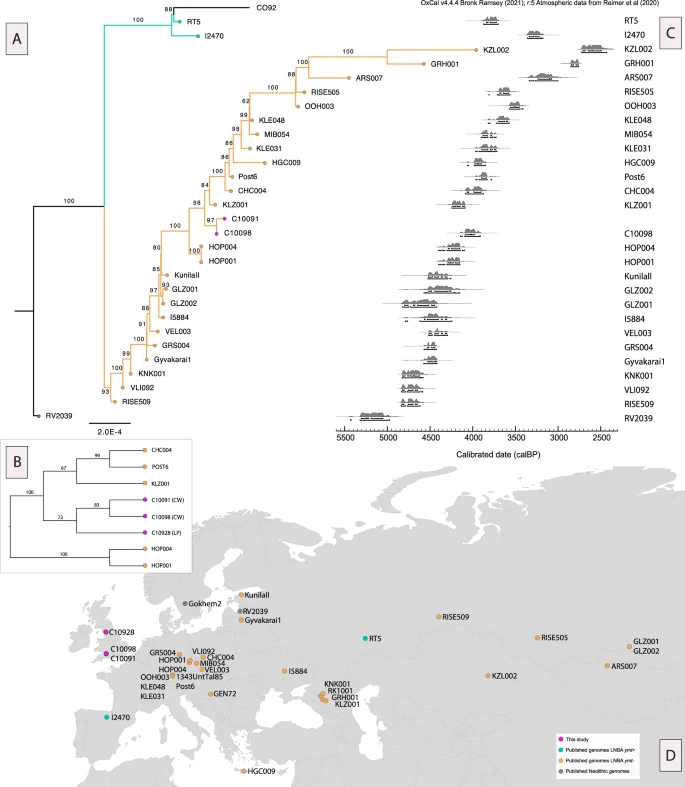Black Death strain identified in individuals buried 4,000 years ago

DNA from a strain of bacteria responsible for the infamous Black Death has been found in the teeth of three individuals buried in the UK thousands of years before the deadly pandemic swept through Europe.
Two of these individuals, determined to be young teenagers, were buried in a mass grave in Charterhouse Warren, Somerset; the third was a middle-aged woman, aged between 35 and 45, buried in a memorial ring at Levens, Cumbria. All three lived around the same time, although it is not clear whether the plague was the cause of their deaths. The burial dates back to around 2000 BC, i.e. around 4000 years ago, in the late Neolithic – early Bronze Age.
The Yersinia pestis strain identified is different from the one that caused the Black Death, an epidemic that started a 500-year plague pandemic that killed millions of people in Europe and the Middle East.
However, these are the oldest identified cases of Y. pestis infection in Britain, suggesting that the plague spread easily, even before it developed the mutations that would contribute to recurring episodes of deadly virulence from the 14th century onwards. .
“The ability to detect ancient pathogens from degraded samples dating back thousands of years is incredible,” explains genomist Pooja Swali of the Francis Crick Institute in the UK.
These genomes can inform us about the spread and evolutionary changes of pathogens in the past and hopefully help us understand which genes may be important in the spread of infectious diseases." We have seen that this lineage of Yersinia pestis, including the genomes in this study, loses genes over time, a pattern that has emerged with subsequent outbreaks caused by the same pathogen."
The second plague pandemic represented a series of rather important events in human history, having altered not only economics, politics and culture, but potentially – albeit questionably – our very genome.
While much is known about the history of the disease, its origins and spread is one aspect genetic investigators are still trying to understand. Traces of it have been found in Eurasia dating back to around 5,000 years ago, to the Late Neolithic and Bronze Age (LNBA).
There are two forms of the disease: bubonic or septicemic plague, transmitted by flea bites, and pneumonic plague, spread by human-to-human aerosol transmission. The most common strains of the LNBA bacterium lack the adaptations for flea transmission, suggesting that earlier forms of plague weren't terribly lethal.
But how transmissible was pneumonic plague? Swali and his colleagues studied the early spread of Y. pestis in Britain by extracting DNA from the teeth of 34 individuals. Tooth roots are known to preserve pieces of microbial DNA in detectable levels, providing researchers with a valuable resource for tracing the history of many diseases.
Interestingly, the Charterhouse Warren mass grave containing the two children is not typical of the period. Additionally, many of the bones of the 28 individuals present showed signs of life-threatening trauma, suggesting that the site was used for the disposal of bodies after a violent event.
It is highly probable that the children were infected with the plague at the time of their deaths, but it is unlikely that infection was the main cause of death. However, it is not possible to establish how the older woman buried in the ringed cairn died.
In all three cases, the DNA of the bacterium lacked the genetic mutation for transmission to fleas. The first identification of this mutation dates back to about 3,800 years ago. So it was the pulmonary variant.
But the new discovery tells us that Y. pestis spread from mainland Europe to the British Isles earlier than previously known. This early and wide geographical spread seems to suggest that pneumonic plague spread not only far, but also quite easily. Further investigations could help reveal the impact it had on humanity at the time.
“We understand the enormous impact of many historical plague epidemics, such as the Black Death, on human societies and health, but ancient DNA can document infectious diseases much further back in time,” says geneticist Pontus Skoglund of the Francis Crick Institute.
"Future research will do more to understand how our genomes have responded to these diseases in the past and the evolutionary arms race with pathogens themselves, which may help us understand the impact of diseases in the present or future."

Thanks to our Telegram channel you can stay updated on the publication of new articles from Economic Scenarios.
The article Identified the strain of the Black Death in individuals buried 4,000 years ago comes from Scenari Economici .
This is a machine translation of a post published on Scenari Economici at the URL https://scenarieconomici.it/identificato-il-ceppo-della-peste-nera-in-individui-sepolti-4-mila-anni-fa/ on Sat, 03 Jun 2023 09:00:46 +0000.


